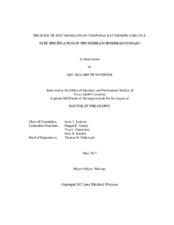| dc.description.abstract | The Midbrain Hindbrain Domain (MHD) is a region of the central nervous system consisting of the midbrain, midbrain hindbrain boundary (MHB) and anterior hindbrain. The MHB is an organizer that patterns the midbrain and anterior hindbrain. It is important to understand how organizers such as the MHB are formed to better understand how the vertebrate brain is patterned and develops. I have examined how timing of signaling by the canonical Wnt/β -catenin signaling pathway affects MHD specification and patterning by inhibiting Wnt signaling at specific developmental time intervals and analyzing the resulting phenotypes by morphological analysis and in situ hybridization.
Four Wnt genes, wnt1, wnt10b, wnt3, and wnt3a, have overlapping expression patterns in the MHD, but their relative roles in MHB development are unclear. wnt3a, wnt1, and wnt10b are activated earlier in development than wnt3. wnt3a, wnt1, and wnt10b have been shown to work in combination to regulate MHB development which lead to the question what is the role of wnt3 in this process. I specifically examined the role of wnt3 during MHB development by knocking down wnt3 in combination with the other three Wnt genes and performed in situ hybridizations using anterior and posterior neural markers.
We observed that after inhibition of Wnt signaling at early developmental time intervals, midbrain and anterior hindbrain formation is disrupted but not MHB development. When Wnt signaling is blocked at later developmental time intervals, MHD patterning and formation are disrupted. Our data show forebrain fates expand posteriorly and midbrain and anterior hindbrain fates are reduced at later developmental stages. These data suggest Wnt signaling represses anterior neural fates and advances posterior neural fates in MHD patterning and specification.
When wnt3 is inhibited in combination with wnt1 and wnt10b, I observed that the MHB is partially reduced, whereas the MHB is absent when wnt3 and wnt3a in combination with wnt1 and wnt10b are inhibited. When wnt3 and wnt3a are blocked, the MHB is absent. These data suggest that these Wnt genes work in combination to regulate MHB formation but have differential requirements in this process.
In conclusion, our results suggest Wnt signaling represses forebrain fates, while promoting midbrain, MHB, and anterior hindbrain. Also, multiple Wnt genes expressed in the MHB regulate MHB formation, but their functions are different. | en |


